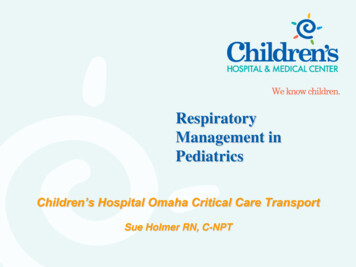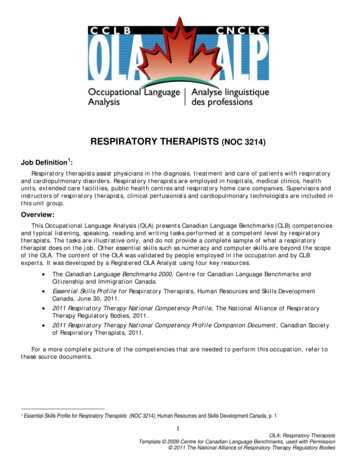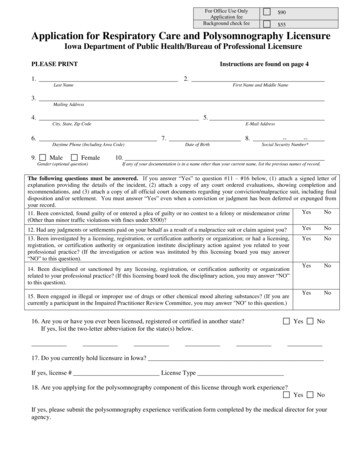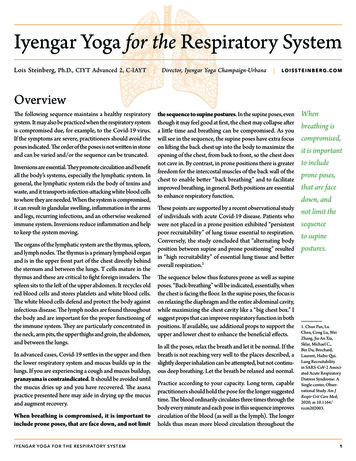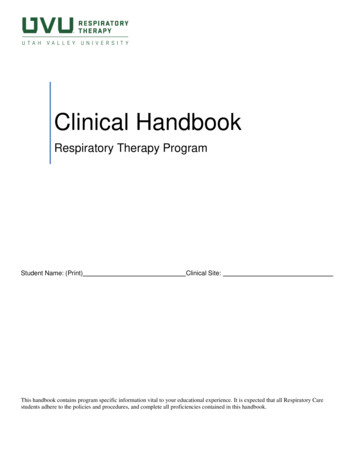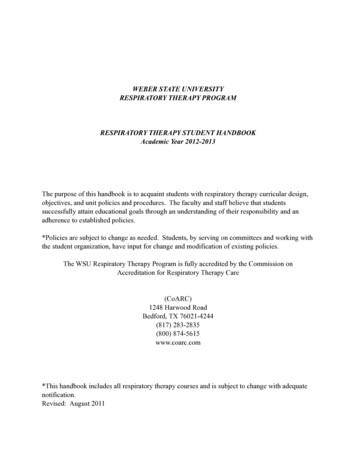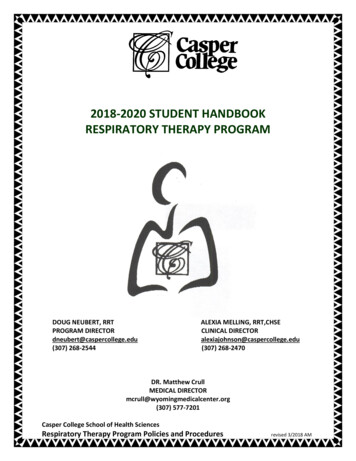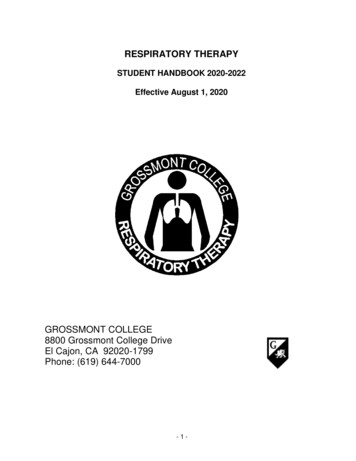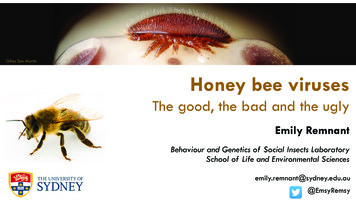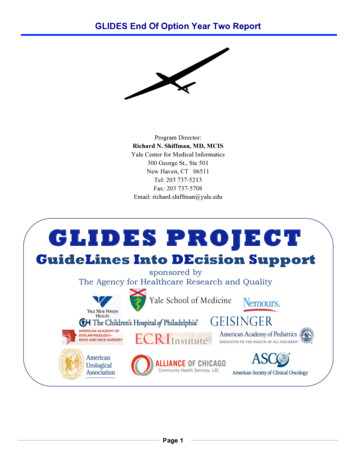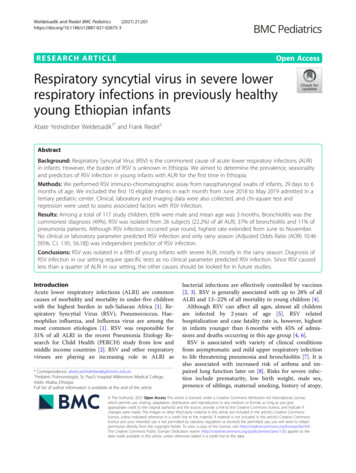
Transcription
Weldetsadik and Riedel BMC Pediatrics(2021) SEARCH ARTICLEOpen AccessRespiratory syncytial virus in severe lowerrespiratory infections in previously healthyyoung Ethiopian infantsAbate Yeshidinber Weldetsadik1* and Frank Riedel2AbstractBackground: Respiratory Syncytial Virus (RSV) is the commonest cause of acute lower respiratory infections (ALRI)in infants. However, the burden of RSV is unknown in Ethiopia. We aimed to determine the prevalence, seasonalityand predictors of RSV infection in young infants with ALRI for the first time in Ethiopia.Methods: We performed RSV immuno-chromatographic assay from nasopharyngeal swabs of infants, 29 days to 6months of age. We included the first 10 eligible infants in each month from June 2018 to May 2019 admitted in atertiary pediatric center. Clinical, laboratory and imaging data were also collected, and chi-square test andregression were used to assess associated factors with RSV infection.Results: Among a total of 117 study children, 65% were male and mean age was 3 months. Bronchiolitis was thecommonest diagnosis (49%). RSV was isolated from 26 subjects (22.2%) of all ALRI, 37% of bronchiolitis and 11% ofpneumonia patients. Although RSV infection occurred year round, highest rate extended from June to November.No clinical or laboratory parameter predicted RSV infection and only rainy season (Adjusted Odds Ratio (AOR) 10.46[95%. C.I. 1.95, 56.18]) was independent predictor of RSV infection.Conclusions: RSV was isolated in a fifth of young infants with severe ALRI, mostly in the rainy season. Diagnosis ofRSV infection in our setting require specific tests as no clinical parameter predicted RSV infection. Since RSV causedless than a quarter of ALRI in our setting, the other causes should be looked for in future studies.IntroductionAcute lower respiratory infections (ALRI) are commoncauses of morbidity and mortality in under-five childrenwith the highest burden in sub-Saharan Africa [1]. Respiratory Syncytial Virus (RSV), Pneumococcus, Haemophilus influenza, and Influenza virus are among themost common etiologies [1]. RSV was responsible for31% of all ALRI in the recent Pneumonia Etiology Research for Child Health (PERCH) study from low andmiddle income countries [2]. RSV and other respiratoryviruses are playing an increasing role in ALRI as* Correspondence: abate.yeshidinber@sphmmc.edu.et1Pediatric Pulmonologist, St. Paul’s Hospital Millennium Medical College,Addis Ababa, EthiopiaFull list of author information is available at the end of the articlebacterial infections are effectively controlled by vaccines[2, 3]. RSV is generally associated with up to 28% of allALRI and 13–22% of all mortality in young children [4].Although RSV can affect all ages, almost all childrenare infected by 2 years of age [5]. RSV relatedhospitalization and case fatality rate is, however, highestin infants younger than 6 months with 45% of admissions and deaths occurring in this age group [4, 6].RSV is associated with variety of clinical conditionsfrom asymptomatic and mild upper respiratory infectionto life threatening pneumonia and bronchiolitis [7]. It isalso associated with increased risk of asthma and impaired lung function later on [8]. Risks for severe infection include prematurity, low birth weight, male sex,presence of siblings, maternal smoking, history of atopy, The Author(s). 2021 Open Access This article is licensed under a Creative Commons Attribution 4.0 International License,which permits use, sharing, adaptation, distribution and reproduction in any medium or format, as long as you giveappropriate credit to the original author(s) and the source, provide a link to the Creative Commons licence, and indicate ifchanges were made. The images or other third party material in this article are included in the article's Creative Commonslicence, unless indicated otherwise in a credit line to the material. If material is not included in the article's Creative Commonslicence and your intended use is not permitted by statutory regulation or exceeds the permitted use, you will need to obtainpermission directly from the copyright holder. To view a copy of this licence, visit http://creativecommons.org/licenses/by/4.0/.The Creative Commons Public Domain Dedication waiver ) applies to thedata made available in this article, unless otherwise stated in a credit line to the data.
Weldetsadik and Riedel BMC Pediatrics(2021) 21:201lack of breastfeeding, crowding and comorbidities, especially chronic neonatal lung disease and congenital heartdefects [4, 9–12].Despite different case definitions for detection of confirmed RSV-ALRI, specificity and sensitivity varieswidely with consistently low positive predictive value[13, 14]. Thus, diagnosis of RSV infection usually requires the use of microbiologic tests [14]. However, if wecould clinically predict the probability of viral ALRI precisely, it would be of importance for rational use of antibiotics, a common problem in our settings [15].RSV and other viral epidemiologic studies are important to determine disease burden, need of diagnostic andfuture vaccination services, and assess risk factors toprotect high risk populations [8, 16, 17]. It also helps todesign preventive and therapeutic interventions forhouseholds, hospitals and health planners by determining RSV seasonal variation in different regions [18, 19].The epidemiology and seasonality of RSV have been thefocus of many investigations. RSV prevalence rates fromprevious studies in infant ALRI ranged from 9% in Nepalto more than 60% in Ghana although the different population of children and methods makes comparison difficult [10, 18, 20]. Other African studies reported also lowprevalence rates in Kenya (12%), Senegal (11.4%),Zambia (15.2%), and Burkina Faso (12%) [1, 20–22].Although RSV is one of the most extensively studiedcauses of ALRI in humans, most studies come from highincome countries (46% from North America) [23]. Research in low and middle income countries are howeverboth limited and none from Ethiopia [23–25]. Thus, weessentially aimed to determine the prevalence and season of RSV infection and factors associated with RSV ininfants less than 6 months of age with severe ALRI forthe first time in Ethiopia.Materials and methodsPage 2 of 9Data collection and proceduresA nasopharyngeal swab was collected from each infantat the bedside by a trained nurse within 48 h of hospitaladmission, using a flexible sterile applicator. The specimen was then immediately tested for presence or absence of RSV fusion protein using RSV immunochromatographic assay (Alere , USA, Scarborough).This assay is a standardized point of care test which isread after 15 min and gives the result as “RSV positive”,“RSV negative” or “Invalid”. The test detects RSV fusionprotein from both RSV A and B subgroups. Sensitivityand specificity of the test was reported to be 93% compared to gold standard viral culture [26].We tested 120 infants, 29 days to 6 months of age, withALRI for RSV antigen with this test, no invalid resultwas found during the study.Socio-demographic, clinical, laboratory and imagingdata of all patients were documented using a semi–structured questionnaire, data were collected by two research nurses working in pediatric emergency and wardsafter training on data collection and the RSV testingprocedure with close monitoring by the principalinvestigator.Data analysis was done using SPSS for Windows Version 20 (SPSS Inc., Chicago, IL) and both descriptiveand analytical methods were used as needed, a p-valueof less than 0.05 was taken as significant. Multivariateanalysis was applied to control confounders and variables with p value of 0.2 on bivariate analysis, and previously known predictors of RSV infection were includedin multivariate logistic regression.Inclusion criteria– Infants 29 days - 6 months of age– Upper respiratory symptoms in the preceding 7 days– Clinical sign of severe ALRI requiring hospitalizationStudy settingThe study was done in the Pediatric Department of SaintPaul’s Hospital Millennium Medical College (SPHMMC)in Addis Ababa, capital city of Ethiopia. The hospital is atertiary academic and referral center for a population of8 million. The Department of Pediatrics has currently114 beds (48 Neonatal beds, 60 pediatric, and 6 pediatricICU beds) and provide care to children from birth to 15years of age.Exclusion criteria– Underlying chronic illness (Cardiac, neurologic, andlung diseases, prematurity and immunodeficiencyincluding HIV infection or exposure)– Infants with Severe Acute Malnutrition (defined byweight for length 3 SD or nutritional edema)Operational definitionSampling methodStudy subjects were selected at admission with ALRI toSPHMMC after checking eligibility criteria and takingwritten informed consent, starting from June 2018 toMay 2019. In each month of the year, the first 10 consecutive eligible cases were tested for RSV antigen.– Severe ALRI: Acute onset (less than 7 days) withrespiratory symptoms (cough, dyspnea, wheezing,tachypnea, grunting ) requiring hospitalization– Bronchiolitis: ALRI with first wheezing with orwithout bilateral fine crackles in an infant with
Weldetsadik and Riedel BMC Pediatrics––––(2021) 21:201preceding upper respiratory infection with orwithout hyperinflation and atelectasis in chest x-ray.Pneumonia: WHO definition excluding thosefulfilling the diagnosis of bronchiolitisBronchitis: ALRI with cough, mild / no tachypnea,rhonchi or coarse crackles on auscultation with orwthout peribronchial cuffing on chest x-ray in an infant with preceding viral upper respiratory infectionOvercrowding: Presence of more than two personsper room of total roomsYoung infants: 29 days to 6 months of age.ResultsPatient characteristicsA total of 117 infants were included in the final analysis out of 120 infants tested for RSV (three were excluded later after a delayed diagnosis of underlyingcomorbidity: one primary immunodeficiency, one Male sex predominated (65%) with male/female ratioof 1.8, and Mean age was 3 (SD 1.8) months. Mostmothers (56%) were uneducated or completed only primary education. Overcrowding was found in 58% households, cigarette smoking was uncommon (2.6% ofhouseholds), exclusive breast feeding was documented in54% of cases (Table 1).Clinical presentationLow fever (axillary temperature 37.5–38.3 C) and nofever (36–37.4 C) were documented in 42% each. Nearlyall (97%) were in respiratory distress. Crackles or wheezewere found in 83% of infants on auscultation. PediatricICU admission was required in 3.4% of the cases for respiratory failure (Table 1).Laboratory and imaging characteristicsWBC was done in all infants and was normal in 80% ofcases (Table 1). Most (71%) had CRP documented andelevated in 22% and was normal or low in 49% of infants. Almost 30% of all CRP 60 mg/L were documented in RSV confirmed cases (Table 1). Blood culturewas positive in 3 infants (2.6%) (first, a 4 months RSVpositive infant with bronchiolitis had hospital acquiredinfection, second, a 2-month infant with RSV negativepneumonia and hospital acquired sepsis and DIC, isolated multidrug resistant Acinetobacter and K. pneumoniae, ventilated in the PICU, had mild pleural effusionon chest Ultra Sound, and died of severe sepsis, the thirdis 4-month infant with unspecified organism). Only halfof the infants had chest x-ray done and 33% were normal while 36% showed hyperinflation and/ peribronchialthickening or atelectasis. Only 10% of the x-rays showedPage 3 of 9isolated consolidation or infiltrate consistent with pneumonia (Table 1).Type of ALRI and RSV infectionBronchiolitis (48.7%) followed by pneumonia (40%) werethe commonest ALRI (Fig. 1, Table 2). RSV infectionwas documented in 26 (male/female ratio of 1) of allyoung infants less than 6 months (22.2%), but in 37% ofthose with bronchiolitis and only 11% of those withpneumonia. Females (31.7%) were slightly more affectedby RSV than males (17.1%), but this was not statisticallysignificant (p 0.11). Most (58%) of the RSV infectionswere documented during rainy season. Although RSVinfection was documented year round, the highest rateof infection occurred in the local summer time (June–August) followed by spring (September to November),while the lowest was in winter (December to February)(Fig. 2).Treatment and outcomeThe mean length of hospital stay was 5 (SD 5.2)days, ranging from 1 to 33 days. Most infants (75%)were treated with antibiotics, while 25% received onlysupportive care with hydration and oxygen. Bronchodilator and epinephrine nebulization were used in48% infants. Steroids (mainly dexamethasone) weregiven in 10% of cases. Ampicillin / gentamicin wasused in half of the cases and a quarter of the infantsreceived broader spectrum antibiotics, mainly Cephalosporines, and vancomycin was also used in 5% ofthe cases.Resolution of ALRI was documented in 98.3% withonly 2 cases having complications, both of whichwere RSV negative: A one-month old infant withbronchiolitis developed persistent atelectasis and required a repeat admission for the same complaint in4 weeks, and one death (0.9%) happened, with a diagnosis of pneumonia and sepsis, the latter being thecause of death (Table 2).Epidemiology and predictors of RSV infectionALRI season, presence of wheeze, and bulging chest, andthe clinical diagnosis of bronchiolitis were significantlyassociated with RSV isolation on bivariate analysis. However, on multivariate regression, only the season wasfound to be independent predictor of RSV infection withadjusted Odds Ratio (AOR) of 9.15 (95% C.I. 1.30, 64.32)(Fig. 2, Table 3). Other variables including sociodemographic, clinical, laboratory, and imaging parameters andoutcome were not associated with RSV infection (Fig. 3,Tables 3 and 4) in this group of young infants less than6 months of age.
Weldetsadik and Riedel BMC Pediatrics(2021) 21:201Page 4 of 9Table 1 Sociodemographic and clinical data (n 117)Sociodemographic data: n (%)AgeSexFamily size (No)Maternal educationResidencyOvercrowdingHousehold smokingInfant feedingSun exposureClinical Presentation: n (%)1–3 mo.63 (53.8)4–6 mo.54 (46.1Respiratory distress113 (96.6)3 (2.6)n.k.1 (0.9)Normal50 (42.7)male76 (65)female41 (35) 459 (50.4)Low fever49 (41.9)5–747 (40.2)High fever14 (12) 711 (9.4)n.k.4 (3.4)No/Primary66 (56.4)Clear chest13 (11.1)TemperatureAuscultationHigh school21 (17.9)Wheeze or crackles103 (88)College9 (7.7)n.k.1 (0.9)n.k.21 (17.9)Urban90 (76.9)Rural22 (18.8)n.k.5 (4.3)Bulging chestDehydrationYes7 (6)No107 (91.5)n.k.3 (2.6)Yes7 (6)Yes63 (58.3)No92 (78.6)No48 (41)n.k.18 (15.4)n.k.6 (5.1)Yes3 (2.6)No98 (83.8)n.k.16 (13.7)EBFBottleYes4 (3.4)No112 (95.7) 5.0002(1.7)5.000–15.00094 (80.3)63 (53.8)15.000–20.00011 (9.4)13 (11.1) 20.0008 (6.8)Mixed25 (21.4)n.k.16 (13.7)Yes68 (58.1)PICU admissionWBC (/μl)CRPCXRNon.k.Monthly income (in ETB)YesNo48 (41)1 (0.9) 2000Blood cultureLow57 (48.7)Positive / high26 (22.2)n.k.34 (29.1)Normal19 (16.2)Pneumonia6 (5.1)Bronchiolitis21 (17.8)Not done59 (50.4)n.k. or not done114 (97.4)positive culture3 (2.6) 2000n.k.Keys: n number of cases, n.k not known, EBF exclusive breast feeding, PICU pediatric intensive care unit, WBC white blood count, CRP C reactive protein, CXR chestx-ray, ETB Ethiopian BirrDiscussionThe epidemiology of viral respiratory infections is notwell documented in Ethiopia, except influenza virussurveillance since 2008 [27, 28], and to our knowledge, this is the first study evaluating the burden ofRSV infection among young infants less than 6months of age with ALRI in the country. Similar toprevious studies [12, 13], the clinical presentation wasnot different between RSV positive and negative infants except for higher rate of wheezing in those withRSV infection. The initial presentation was dominatedby respiratory distress, while high fever wasuncommon in our patients. The absence of a specialclinical predictor for RSV infection in our setting indicates the need to use virus specific tests if we wantto diagnose RSV infection with certainty as alsoshown in the PERCH study [12, 14].Our data showed that RSV plays an important role asa cause of severe ALRI in Ethiopian infants. We alsodemonstrated that RSV is much more prevalent than influenza in young children with ALRI, for whom a 3%rate was documented previously in Addis Ababa [27].In contrary to the high RSV rate in western settings[29] and a study from Ghana [18], we documented RSV
Weldetsadik and Riedel BMC Pediatrics(2021) 21:201Page 5 of 9Fig. 1 Rate of RSV infection and type of Lower Respiratory Infections (LRI), (n 117)Table 2 Diagnosis, treatment and outcome (n 117)Diagnosis and treatmentn%OutcomeType of LRI5748.7RSVBronchiolitisLOS (n 88)Supportive 9177.8 3 days3438.64–7 days3336.47–14 days2125Complete resolution11598.3Persistent ne nebulization3328Yes1210No10388PPE / sup- puration10.8No antibiotics2924.8Air leak00Death10.9Ampicillin2622.2Ampicillin Gentamicin3025.6Cephalosporin2521.4Vancomycin Cephalosporin65Key: LOS length of hospital stay in days, PPE parapneumonic effusionOutcome
Weldetsadik and Riedel BMC Pediatrics(2021) 21:201Page 6 of 9Fig. 2 Seasonal variation of RSV in % of RSV in Lower Respiratory Infections (LRI)infection in only a fifth of all infant ALRI and about athird of bronchiolitis cases.RSV prevalence in our studywas similar to a study in Maputo [30], but higher thanother studies documenting 9–15% prevalence [10, 20–22]. While the strict exclusion of risk populations mayaffect our prevalence rate, the younger age of our patients (less than 6 months) may also be the reason forhigher prevalence compared to the previous Africanstudies [20–22]. Additionally, other viruses and bacteriaprobably play a more important role in developing countries compared to western settings, where RSV has amuch higher importance than other viruses and bacteria[2, 29, 31]. However, vaccination was up to date and almost all infants had a preceding upper respiratory infection in our study, thus bacterial etiologies were unlikelyin the majority of the patients, although it was not explored adequately.Male gender was found to be a risk for ALRI and our result of male/female ratio of 1.8 is in line with this observation [32]. However, male gender preference and morehealth care seeking in males had also been recognized inother developing countries [33]. There was no gender difference in the RSV rate in our study, although male gender hasbeen documented as a risk factor in previous studies [34].Only the rainy season of the year was independentlyassociated with RSV infection in our study. AlthoughRSV infection was documented year round, the highestrate was found from June to November which is therainy season in Addis Ababa. Although we didn’t measure meteorological factors in our study, this time is associated with cold weather and high air pollution (PM 2.5)in Addis Ababa and coincides with higher rates of respiratory infection and admissions in young children[35]. Recent studies have documented the role of airTable 3 Bivariate and multivariate analysis of factors associated with RSV infection (n 117)Variablep valueCOR (95% C.I)p valueAOR (95% CI)1Age0.11–0.0613.5 (0.89,206)2Sex0.072.25 (0.93,5.47)0.060.29 (0.08,1.06)3Presence of wheeze0.0015.10 (1.97,13.02)0.173.33 (0.53,20.97)4Type of LRI0.0024.87 (1.78,13.27)0.690.53 (0.09,3.22)5Season of LRI0.022.92 (1.20,7.13)0.029.15 (1.30,64.32)6Bulging chest0.045.33 (1.11,25.56)0.254.62 (0.33,63.93)7Infant feeding0.12–0.514 (0.54,29.7)8WBC0.34–0.99–9CRP0.520.66 (0.23,1.91)0.470.50 (0.08,3.12)10CXR0.78–0.481.85 (0.33,10.38)Key: COR crude odds ratio, AOR adjusted odds ratio, CI confidence interval
Weldetsadik and Riedel BMC Pediatrics(2021) 21:201Page 7 of 9Fig. 3 RSV positive cases distributed by age group (N 26)pollution in RSV infection [36]. RSV seasonality had alsobeen typically associated with rainy season in tropical regions, but dry season in temperate zone [19, 37]. Whilethe association of the RSV peak with rainy season is explainable by our tropical climate, air pollution and coldweather during this time, we however cannot determineseasonality as our study covered a period of single year.Diagnosis of viral ALRI can prevent unnecessaryantibiotic treatment, especially in previously healthychildren with low risk of bacterial infection. Seriousbacterial infections are rare in those previouslyhealthy and vaccinated children with bronchiolitis[38]. One-fourth of our patients were not treated withantibiotics, but there was no difference in RSV positive compared to RSV negative infants in use of antibiotics. The outcome of infants treated with antibioticversus supportive care alone was also similar. Ourstudy also showed that judicious withhold of antibiotics can be practiced in severe ALRI where a viraletiology is most likely, without compromising outcome - at least in specialized centers of resource limited settings, especially in children with updatedvaccinations and without comorbidity [39].Antibiotic choice was not strictly followed as perstandard recommendations, with a third of patientsreceiving highly broad spectrum antibiotics (mostlythird generation Cephalosporines). Despite their irregular availability in low income settings and theirinherent limitations, point of care tests should contribute in the future to decrease antibiotic use, indicate the choice of antibiotic and avoid both overand under treatment of children with ALRI [12].Antibiotics are not indicated as prophylactic management in viral ALRI, and RSV infection has beenshown to be rarely complicated by bacterial supperinfection [12, 38, 40].Complications were low in both RSV positive and RSVnegative infants in our study. This could be due to thepredominantly viral etiology of the ALRI in our patientsas evidenced by preceding cold, low fever, mostly normalWBC and CRP. Furthermore, most infants had bronchiolitis and only 10% of CXRs confirmed pneumonia.The low mortality (0.9%) is also explained by exclusionof infants with comorbidities and with the rarity of deathin previously healthy infants with ALRI receiving propertreatment [40].Our study has some limitations. First, we used antigen detection without a molecular or culture confirmation. Additionally, our low sample size and inclusionof selected severely ill cases from a single tertiarycenter limits generalizability and identification of predictors of RSV infection in our population of younginfants. RSV prevalence in the general pediatric population in our setting is also not possible from ourstudy and this will require a separate study with inclusion of older children and milder cases. We alsocould not determine seasonality exactly because of asingle year coverage. Another limitation of our studydesign is that it cannot doubtlessly prove a directcausation relation of RSV being the cause of theALRI, although previous case control studies had documented that RSV isolation from upper airways reflect genuine ALRI caused by RSV, unlike by otherviruses and bacteria [2, 19].These limitations of ours may be addressed in futurestudies by conducting multicenter case control studiesusing multiplex-PCR for more comprehensive description of ALRI etiologies in Ethiopia.
(2021) 21:201Weldetsadik and Riedel BMC PediatricsPage 8 of 9Table 4 Clinical characteristics of RSV positive young infantswith LRI (n 2No830.8Normal2492.315.000–20.000 /μl27.3Age in monthsSexFeedingWheezeAbbreviationsALRI: Acute Lower Respiratory Infection; CI: Confidence Interval; CRP: CReactive Protein; OR: Odds Ratio; AOR: Adjusted Odds Ratio; HIV: HumanImmune deficiency Virus; ICU: Intensive Care Unit; LRI: Lower RespiratoryInfection; PCR: Polymerase Chain Reaction; RSV: Respiratory Syncytial Virus;SPHMMC: Saint Paul’s Hospital Millennium Medical College; WBC: WhiteBlood Cell count; WHO: World Health OrganizationAcknowledgmentsWe sincerely acknowledge Professor Thomas Freischer and Dr. MohammedChisti for their valuable comments of the manuscript, and SPHMMC forfunding the research.Authors’ contributionsBoth authors have been involved in conception, design, data analysis andmanuscript preparation. The author(s) read and approved the finalmanuscript.FundingThe research was funded by SPHMMC.Availability of data and materialsData can be provided from the PI (AYW) with a request.DeclarationsWBCCRP 36 mg/L1557.736-60 mg/L27.7 60 mg/L415.4Ethics approval and consent to participateEthical clearance was obtained from SPHMMC Institutional Review Board(pm 23/470) before commencing the study and there was no side effectobserved except for a mild discomfort during the specimen collection fromthe nasopharynx. The study was done following the methods describedabove and in accordance with the relevant guidelines and regulations.Informed consent was obtained from parent and/or legal guardian in allinfants included in the study.Consent for publicationNot applicable.Competing interestsWe declare no competing interest in relation to this 4Autumn623.1Author details1Pediatric Pulmonologist, St. Paul’s Hospital Millennium Medical College,Addis Ababa, Ethiopia. 2Pediatric Pulmonology, University Medical CenterHamburg-Eppendorf, Hamburg, Germany.Received: 20 February 2021 Accepted: 19 April 7Key: WBC white blood count, CRP C reactive protein, Dx DiagnosisIn conclusion, our study showed that RSV is a common cause of ALRI in young Ethiopian infants lessthan 6 months of age. The rainy season is associatedwith the highest RSV infection unlike in temperatezones. No clinical, laboratory or imaging parameterspredict RSV infection in our setting in a highly selected young infants less than 6 months of age, underscoring the paramount need for RSV specific tests toconfirm the diagnosis in order to reduce the abuse ofantibiotics among these young infants presenting withALRI.References1. GBD 2015 LRI Collaborators. Estimates of the global, regional, and nationalmorbidity, mortality, and aetiologies of lower respiratory tract infections in195 countries: a systematic analysis for the Global Burden of Disease Study2015. Lancet Infect Dis. 2017;17(11):1133–61.2. O’Brien KL, Levine OS, Knoll MD, et al. The pneumonia etiology research forchild health (PERCH) study group. Causes of severe pneumonia requiringhospital admission in children without HIV infection from Africa and Asia:the PERCH multi-country case-control study. Lancet. 2019;394(10200):757–79. https://doi.org/10.1016/S0140-6736(19)30721-4.3. Weinberger Israel DM, Givon-Lavi N, Yonat Shemer-Avni Y, et al. Influence ofpneumococcal vaccines and respiratory syncytial virus on alveolarpneumonia. Emerg Infect Dis. 2013;19(7):1084–91. https://doi.org/10.3201/eid1907.121625.4. Shi T, David A McAllister, and Katherine L O'Brien, et al. Global, regional, andnational disease burden estimates of acute lower respiratory infections dueto respiratory syncytial virus in young children in 2015: a systematic reviewand modelling study. Lancet. 2017;390(10098):946–58. https://doi.org/10.1016/S0140-6736(17)30938-8.5. Walsh EE. Respiratory syncytial virus infection: an illness for all ages. ClinChest Med. 2017;38(1):29–36. https://doi.org/10.1016/j.ccm.2016.11.010.
Weldetsadik and Riedel BMC .21.22.23.24.25.26.(2021) 21:201Scheltema NM, et al. Global Respiratory Syncytial Virus-Associated Mortalityin Young Children (RSV GOLD): A Retrospective Case Series. Lancet GlobHealth. 2017;5(10):e984–91.Munywoki PK, Koech DC, Agoti CN, Bett A, Cane PA, Medley GF, et al.Frequent asymptomatic respiratory syncytial virus infections during anepidemic in a rural Kenyan household cohort. J Infect Dis. 2015;212(11):1711–8. er K, van der Ent CK, Ermers MJJ, Uiterwaal CSPM, Rovers MM,Bont LJ, et al. Increased risk of wheeze and decreased lung function afterrespiratory syncytial virus infection. PLoS One. 2014;9(1):e87162. https://doi.org/10.1371/journal.pone.0087162.Stein RT, et al. Respiratory Syncytial Virus Hospitalization and Mortality:Systematic Review and Meta-analysis. Pediatr Pulmonol. 3570.Chu HY, et al. Respiratory Syncytial Virus Infection in Infants in Rural Nepal. JInf Secur. 2016;73(2):145–54. https://doi.org/10.1016/j.jinf.2016.05.007.Shi T, et al. Risk Factors for Respiratory Syncytial Virus Associated with AcuteLower Respiratory Infection in Children under Five Years: Systematic Reviewand Meta–analysis. J Glob Health. 2015;5(2):020416.Higdon MM, et al. Association of C - reactive protein with Bacterialand Respiratory Syncytial Virus–Associated Pneumonia amongChildren Aged 5 Years in the PERCH Study. Clin Infect Dis. 2017;64(Suppl 3):S378–86.Nyawanda BO, et al. Evaluation of Case Definitions to Detect RespiratorySyncytial Virus Infection in Hospitalized Children below 5 Years in RuralWestern Kenya, 2009–2013. BMC Infect Dis. 2016;16:218.Thornton HV, et al. Clinical Presentation and Microbiological Diagnosis inPaediatric Respiratory Tract Infection: A Systematic Review. Br J Gen Pract.2015;65(631):e69–81. https://doi.org/10.3399/bjgp15X683497.Tekleab AM, Asfaw YM, Weldetsadik AY, Amaru GM. Antibiotic prescribingpractice in the management of cough or diarrhea among childrenattending hospitals in Addis Ababa: a cross-sectional study. Pediatr HealthMed Ther. 2017;8:93–8. https://doi.org/10.2147/PHMT.S144796.Poletti P, Merler S, Ajelli M, et al. Evaluating vaccination strate
chromatographic assay (Alere , USA, Scarborough). This assay is a standardized point of care test which is read after 15min and gives the result as "RSV positive", "RSV negative" or "Invalid". The test detects RSV fusion protein from both RSV A and B subgroups. Sensitivity and specificity of the test was reported to be 93% com-
